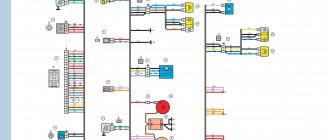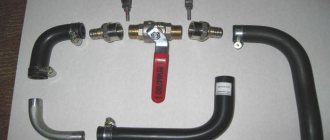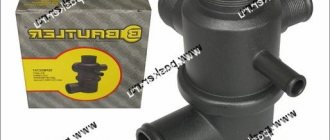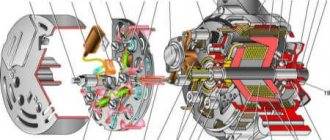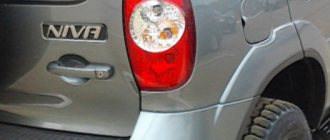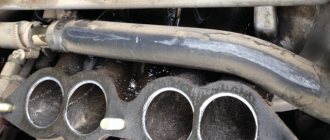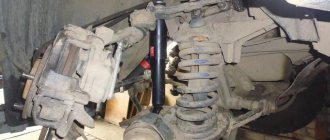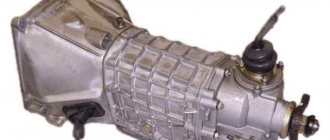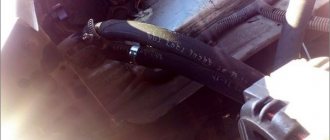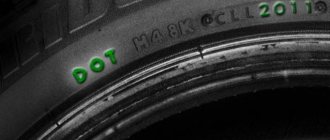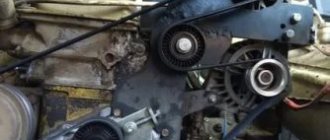Features of replacing the heater radiator in a Chevrolet Niva with and without air conditioning
The heating system of any vehicle has its own components that ensure the full functioning of the entire device.
The stove radiator plays an important role in the operation of the system. Situations arise when the device fails and stops working. To fix any serious problem, you will have to dismantle the unit. The radiator is located according to a special design. The article will tell you in what cases the radiator requires replacement and how to replace it yourself.
How to replace the heater radiator on a Chevrolet Niva without air conditioning
Many motorists are often interested in the question of how to replace the radiator of a Chevrolet Niva stove without air conditioning. To carry out all the actions, you will initially need to unscrew the bolts located on the cylinder block. To avoid damaging the outer shell of the expansion tank cap, it must be carefully removed.
In addition to this option, experts are considering another method, more practical. For example, you need to use a new hose to remove liquid that gradually accumulates in the container.
What tools will you need?
To carry out the procedure you will need the following equipment:
- screwdriver;
- pliers;
- wire cutters;
- socket heads - you can choose the appropriate size (8, 10, 14).
Preparation
There are two options for draining the coolant:
- Open the hood lid. Use the front part of the cylinder to eliminate fluid.
- Remove the expansion tank cap and use a new hose.
Important! When replacing a part, the airbags may deploy. To prevent this from happening, you need to turn the key in the ignition switch to the “Lock” position. Experts also recommend disconnecting the ground on the battery. After completing all the steps, you need to wait a few minutes. This is done to discharge the backup capacitor.
If you have an air conditioner, the process of replacing the heater becomes much more complicated. Therefore, experts are considering the following options to help with operations:
- without removing the instrument panel, the air conditioning system is depressurized;
- If the dashboard is disassembled and the steering wheel is removed, then the operation of the air conditioner is significantly improved.
How to remove a stove radiator
Removing the heater radiator begins with removing the glove compartment. The self-tapping screws for fastening the trim are removed from both sides at the passenger's feet. After performing these steps, it is necessary to remove the terminal of the lighting fixture.
When the rubber hose clamps become loose, they can be easily removed. As soon as the hose is removed, the heat exchanger fasteners are unscrewed.
To securely fix the radiator, it is necessary to glue the edges using foam rubber due to the leaky connection. This will prevent air from getting inside.
The frame of the new heat exchanger is secured with plastic. Only after this is it placed on the seat.
Several replacement methods
In practice, two options are being considered for replacing the Chevrolet Niva 2006 heater.
First way
It is important to note that the heating system retains voltage for up to 2 minutes.
Initially, remove the cap from the expansion tank and unscrew the drain bolt located at the bottom of the engine. You can also disconnect the throttle body cooling tube. As an alternative, you can use a hose with which the coolant can be transferred to a special container.
Next, the radiator is replaced. It is not necessary to remove the instrument panel at all. Initially, you need to remove the heater radiator and disconnect the air duct. Loosen the clamps to make it possible to remove the rubber tube.
Second way
You will need to use a small container. To avoid the formation of puddles in the interior, fabric or film is recommended.
Step-by-step instructions for the entire process
Using a flat-head screwdriver, pry the plug off the panel. Next, press the latches, which are located at the bottom of the structure, and then lift the pillow up. Use a wrench of the appropriate size to unscrew the airbag mounting bolts.
Installation of the ventilation grille plugs is carried out by unscrewing the screws, as well as removing the grille itself. Next, you need to remove the tape and remove the air duct using the appropriate tool.
To carefully remove the air duct on the passenger side, you will need to dismantle the ventilation grille. Then remove the tape.
The pipe in the passenger's feet is dismantled. Initially, unscrew the hose fasteners. To remove the air conditioner evaporator, remove the fuse box along with the control unit.
Important! When removing the fan, remove the air filter. Then unscrew 4 self-tapping screws, with which the electric motor is attached.
To place the structure, select the right side. Next, remove the latches (there are only 6 of them). They are pryed off with a screwdriver. Once the steps are completed, the structure can be separated and carefully removed. To disconnect the fan components, you need to remove the latches.
The next step is to remove the air conditioning system tube. Since there is a possibility of freon escaping, it is advisable to use special safety glasses during the procedure.
The nut is unscrewed. The fastening bolts must be carefully removed so as not to damage the nuts. You also need to remove the self-tapping screw, which is located in the same place as the radiator pipe itself.
In the cabin, unscrew the evaporator mounting bolts, as well as the self-tapping screw. The evaporator nozzle should be on the right side until it comes free.
Installing a new heater
Before replacing the old heater with a new one, the axis of the structure is lubricated with a special lubricant. Reassemble the parts in reverse order. When installing the impeller, it is moved in different directions. Then you should make sure whether or not a complete landing has been made on the motor shaft.
About removing other elements
Taking advantage of the moment when part of the Chevy Niva’s interior has been disassembled, you can simultaneously replace other parts if they are faulty. If it is necessary to replace the fan, then the disassembly procedure is carried out in the same way, only at the end the motor and turbine located above the removed glove box are dismantled. The sequence of actions is as follows:
- Disconnect the motor power supply terminal.
- Disconnect the air duct from the supercharger.
- We unscrew 3 screws and dismantle the fan with turbine.
- To separate the turbine, simply remove the spring-loaded washer.
In the same opening behind the glove compartment there is another important part responsible for the forced supply of air into the cabin - a resistor. A sign of failure - the fan speed switch operates only in one position - “4”, that is, at full power. Then the resistor, attached with a self-tapping screw to the panel behind the glove box, is replaced.
What tools will you need?
To change the Chevrolet Niva heater tap yourself, you will need:
How to remove the evaporator and fan
Let's look at how to remove the heater control unit on a Chevy Niva. This procedure is performed through the glove compartment. You will need to disconnect the negative on the battery according to the following diagram:
- the dashboard is removed;
- the connector is disconnected;
- the heater housing rotates;
- The device is being checked.
How to remove a radiator
To prevent antifreeze from leaking onto the floor, use plastic film, otherwise the floor will be covered with antifreeze.
It is recommended to first remove the heat exchanger and tighten the pipe. To complete the procedure, loosen the clamps. Then they are unscrewed and removed.
How to replace a radiator without removing the instrument panel
The device is replaced in stages:
- Remove the glove box and disconnect the air duct.
- To simplify the process of removing the rubber tube to drain the remaining liquid, loosen the bolts.
- The structure is attached using two screws.
- Using a side cutter, remove a piece of plastic that interferes with the dismantling of the structure.
- Then a new radiator is prepared. To prevent air from passing through the cracks, glue is applied around the perimeter.
labavto.com
The heating system cannot fully function without a heating radiator. If it breaks down, not only is there no interior heating, but the engine may also overheat. Based on the characteristic signs, you can determine whether the unit is faulty and, if necessary, replace it with a new one. Any car enthusiast can replace the heater radiator on a Niva Chevrolet.
Design and malfunctions of the heating system
The Niva Chevrolet car is equipped with a heating system that not only heats the interior in cold weather, but also performs a cooling function and protects the engine from overheating. Its design includes the following elements:
- frame;
- air ducts;
- stove radiator;
- air filter;
- fan;
- ECU;
- tap;
- water pump;
- evaporator;
- compressor.
The device of the stove of the Niva Chevrolet car
The Chevrolet Niva is equipped with a liquid-type heater. It supplies warm air to the cabin and cools the engine, overheating of which can lead to disastrous consequences and costly repairs.
Without air conditioning
The Chevrolet Niva heating system consists of the following elements:
- ventilation duct;
- windshield heating duct;
- intermediate body;
- air intake filter;
- fan;
- interior heating duct;
- foot heating duct;
- heater radiator.
The intensity of the hot air supply is regulated using dampers. The air duct system distributes the heat flow to various areas of the cabin: windshield, side windows, legs, doors, etc. In addition, there is a four-speed air supply switch.
Heating system for the interior of a Chevrolet Niva car, where 1 is the side deflector air duct; 2 — windshield air duct; 3 - intermediate body; 4 - intermediate air duct; 5 — outside air filter housing; 6 — fan housing of the heating and ventilation system; 7 — central deflector; 8 — air duct for blowing the front passenger’s feet; 9 — facing of control units; 10 — front air duct for blowing the legs of rear seat passengers; 11 — rear air duct for blowing the legs of rear seat passengers; 12 — heater assembly; 13 — air duct for blowing the driver’s feet; 14 - side deflector
With air conditioning
The air conditioning system allows you to regulate the temperature and humidity in the cabin. Before turning on the air conditioner, the heater fan is turned on, and the temperature control knob is set to minimum. Almost the entire air conditioning system is located in the engine compartment. Only the evaporator is brought into the cabin between the heater and the electric motor, providing heat exchange between the incoming air and the refrigerant.
The main signs that a Niva Chevrolet heater radiator needs to be replaced
If you drive a Chevrolet Niva for a long time and do not do or check anything in it, then an unpleasant situation can happen when the car becomes cold in winter because the heater will not work properly. To prevent this from happening suddenly, you need to take into account the following signs associated with the cabin radiator (also called a heat exchanger):
- if antifreeze appears under the driver's mat, this is a serious sign;
- the smell of antifreeze appeared in the cabin;
- a greasy coating began to appear on the glass;
- the air heats up slightly during the cold season;
- Antifreeze in the cooling system must be constantly topped up.
If there are no antifreeze leaks at the joints, it means that all of them need to replace the heater radiator. And then, you can see this just by looking at the radiator; if it is covered in drips, then it is clear that it must either be repaired or replaced. Then you need to choose a new stove radiator; they are usually made from aluminum or copper; both are good, depending on which one you already like.
Replacement of the Chevrolet Niva heater radiator with air conditioning. Difficult, but possible
Sooner or later, you may need to replace the radiator of the Chevrolet Niva stove with air conditioning. This is due to the tendency for this element to maintain a normal microclimate in the cabin to break down. After all, gone are the days when copper radiators were installed in AvtoVAZ’s creations; they were essentially eternal. Aluminum parts are now being installed, which does not have the best effect on the operating life of the stove.
At the same time, many drivers are afraid to do repair work themselves and turn to services. They don’t like this work there, because the volume is large, not very comparable with the payment, and they often do it not very well. In this regard, it is advisable to make the replacement yourself.
Replacing the Chevrolet Niva heater radiator: preparation
To replace you will need the following tools:
- 14" head with long knob;
- 10" head with long knob;
- head on "8";
- open-end wrenches;
- flathead and Phillips screwdrivers, available in a set;
- pliers that are needed to clamp and grip parts of various shapes.
Next, be sure to drain the antifreeze from the cooling system. When replacing the heater radiator on a Shnivy, the coolant is usually drained in the following ways:
- open the hood lid, open the cap on the expansion tank, on the front part of the cylinder block, drain the liquid through the drain hole;
- There is another way - you also need to open the cap of the expansion tank, remove the clamp on the throttle body hose, pull out this hose, and instead put another hose through which the liquid will immediately flow into the bucket.
Replacing a stove radiator on a Chevrolet Niva with air conditioning
To carry out the work you will need a new heater radiator and the following tools:
- set of open-end wrenches;
- flat and Phillips screwdrivers;
- pliers;
- hacksaw for metal.
In addition, you should prepare a container for draining antifreeze in advance.
Procedure for replacing the heater radiator
To replace the heater radiator on a Chevrolet Niva with air conditioning, you must perform the following steps.
- Use a Phillips screwdriver to unscrew the screws on the side panel in the cabin and the screws securing the glove compartment.
The panel on the passenger side is unscrewed with a Phillips screwdriver
When dismantling the heater radiator, you need to remove the cabin filter
To gain access to the heater radiator, you need to unscrew the evaporator mounting bolts
Under the evaporator there is access to the radiator pipes and mounts
To remove the radiator, the mounting strips are bent
Video: replacing a stove radiator on a Niva with air conditioning
Instructions on how to change the heat exchanger of a Chevrolet Niva without air conditioning
The manufacturer advises replacing the heat exchanger after the dashboard has been completely disassembled. But you can do without these complex steps; to replace the Chevrolet Niva heater radiator, you just need to do the following:
- remove the glove box, unscrew all screws using a Phillips screwdriver;
- remove the lower air duct, which is secured with one screw, this air duct is directed towards the feet of the right passenger;
- on the lower pipe, you need to loosen the clamp, take a container to drain the liquid remaining in the radiator;
- Unscrew the clamp on the upper pipe and tighten it too;
- Unscrew the screws that hold the radiator, and then pull the radiator towards you so that it rests against the upper air duct;
- unscrew the nut 8, it holds the relay cover, remove this cover;
- Next, you need to use pliers to bite off the corner of the plastic radiator housing and pull the radiator out, pulling it towards you.
Replacing a stove radiator on a Chevrolet Niva without air conditioning
To replace the stove radiator on a Chevrolet Niva you will need the same tools. However, the replacement algorithm is slightly different.
Sequence of actions when replacing a stove radiator
The procedure for replacing the heater radiator on a Chevrolet Niva without air conditioning is as follows.
- All antifreeze is drained from the heating system. Complete draining of the coolant takes 7–10 minutes.
Before replacing the heater radiator, it is necessary to drain the antifreeze from the expansion tank
The glove box can be removed using a Phillips screwdriver
When removing the pipes, place a small antifreeze container under the radiator
The heater radiator is attached to the body with two bolts
The corner of the plastic frame is broken off with pliers or cut off with a hacksaw
Video: replacing a stove radiator on a Niva without air conditioning
Installing a new heat exchanger
- take a new radiator and glue a layer of foam rubber around the perimeter, you can take any glue like Moment, let it dry;
- Now you need to do everything in the reverse order, installing a new radiator, but you will also have to remove the corner of the plastic case on the new radiator.
Put the pipes in place, tighten the clamps, tighten the drain bolt on the cylinder block. When everything is assembled, you need to add the required amount of coolant into the tank. And with this, the procedure for replacing the Chevrolet Niva radiator is completed, after a couple of days you can check the coolant level, it should be normal.
And then a more detailed video on how to replace the radiator of a Chevrolet Niva stove:
Source: auto-cool.com
How to replace the heater on a Niva Chevy without air conditioning
Taking into account the rich experience of car enthusiasts, it can be argued that replacing the radiator of a Chevrolet Niva heater without air conditioning can be done using a simplified technology without removing the dashboard. It is necessary to dismantle the glove compartment by unscrewing the screws with a short Phillips screwdriver, then remove the passenger footwell heating duct. Now there is convenient access to the stove pipes.
Having loosened the clamps and removed the hoses from them, you need to drain the remaining coolant into a previously prepared container. After unscrewing the two screws that secure the radiator, you need to push it towards the right door until it rests against the heated glass air duct. The next stage is the elimination of the last obstacles that prevent the removal of the stove. Unscrew the relay with an 8 mm wrench, then very carefully cut off the plastic corner of the radiator mounting, as shown by the red line in the figure. After this, the heat exchanger can be easily pulled out.
Place for cutting the radiator housing
Before installing a new radiator, saw off the corner of the plastic fastening and install the removed parts in the reverse order. To fix the heat exchanger more securely, you can glue a thin layer of foam rubber around its perimeter.
The heater radiator is an important link in the vehicle’s ventilation, heating and air conditioning system. The microclimate in the cabin and the functioning of the system that prevents icing of windows and rear-view mirrors depend on its effective operation. For a number of reasons, the heater fails. Despite the fairly high labor intensity of the radiator replacement procedure, it can be done with your own hands. Removing and installing a stove with air conditioning is much more difficult compared to radiator models without it. The process requires dismantling a large number of components: dashboard, steering column, decorative elements. It is better to carry out replacement at a service station, where they will provide a guarantee for the work performed and the installed spare parts.
How to replace the Chevrolet Niva heater radiator yourself
Unfortunately, we have to put up with the fact that the heater radiator on a Chevrolet Niva sometimes fails and has to be replaced. The reason for the failure is some parts made of aluminum. Agreeing that the stove has begun to heat poorly is not only difficult, but also completely wrong. The correct temperature regime ensures the maintenance of an excellent microclimate in the cabin. It is comfortable to travel in such a car even for a long period at any time of the year.
So, if you are faced with poor performance of the stove, having found out that the main cause of the problem is the radiator, we do not recommend that you rush to the service station. The local craftsmen will quickly carry out the work, but will demand a tidy sum. We suggest you save it, keep it in your pocket, and do the work yourself. I would also like to note that sometimes service stations employ hacks who are ready to blindside you by ripping off your money. As a result of such “masterful” work, you will soon need to carry out repairs again. So it’s much easier to do everything yourself at once.
Heater malfunctions on Niva Chevrolet
The heating system of the Chevy Niva largely depends on the efficient operation of the radiator, which accounts for the largest number of complaints. In addition to defects in its design, the operating conditions of the vehicle play a large role in the heat transfer process. Since the Chevrolet Niva is an SUV, we can most likely say that it will not be used in urban conditions, which will ensure that the radiator contains:
- dust;
- insects;
- plant pollen;
- fluff of flowering trees.
Poor operation of the heater can be caused by mechanical clogging of its channels with particles of sealant, metal inclusions formed during friction of rotating parts, for example, an engine pump.
Poor-quality coolant with impurities of sand or other particles that got into the expansion tank when poured also negatively affects the operation of the stove. A common cause of malfunction is leaks of the radiator itself, which occur when its seal is broken - as a result, drips and puddles appear on the front seat mats, and an oil film forms on the windshield on the passenger compartment side.
Of these problems, you can really only get rid of contamination of the heat exchanger from the outside. It is necessary to free it from foreign bodies that prevent air from flowing around the radiator cells. To eliminate other causes, you will have to change this product.
Replacement process
Because replacing a heater core is not an easy process, it should be started when there are compelling reasons and you observe signs that clearly indicate problems in the heating system. Experienced technicians share recommendations based on which you can make a “diagnosis” for your car, indicating that it is time to replace the radiator. If the stove begins to heat poorly, so you constantly feel chills in the cabin of your vehicle, then there is a problem with the heating. If, in addition, you smell antifreeze, then your fears are even more confirmed. You should be even more concerned if you begin to notice that the level of coolant used is constantly decreasing, and under the carpet in the cabin you suddenly find a “swamp” of greasy liquid.
First, of course, check all the pipes and hoses that are part of the heating and cooling system. Make sure they are intact. If this is so, it means that the culprit of such troubles is, after all, your stove radiator, the resource of which has already been exhausted. Even if you don’t have the knowledge of how to change a radiator, don’t give in to the problem. We are ready to help you and give specific recommendations, based on which you will skillfully replace the heater radiator on a Chevrolet Niva with and without air conditioning.
There are two ways to replace the radiator. The first method involves carrying out work that does not require removing the torpedo. However, this method is accompanied by a clear disadvantage, namely that during the task the air conditioner will depressurize, so upon completion it will have to be refilled with refrigerant. The second method can be done by removing the dashboard. Unfortunately, such a replacement of the heater radiator on your Chevrolet Niva will be accompanied by a greater expenditure of physical and time resources. Decide which method will be preferable for you, study the recommendations we offer and get started.
First way
This method is suitable for those who are used to performing all actions at lightning speed, since they cannot allow their vehicle to simply sit idle in the garage. The main disadvantage of this method is that at the very beginning of the action you must release all the freon from the air conditioner. If you want to make the reassembly process easier for yourself, take care of this before disassembling, arm yourself with a marker and mark all the removed bolts, screws and other components.
First, unscrew all the bolts and remove the glove compartment. Next, refocus your efforts on the airbag, if you have one. Remove the passenger air duct by unscrewing the bolts and disconnecting the plugs. Don't be afraid that even when you apply force, the air duct won't give way to you. The manufacturer sometimes glues them together with tape, so increase your pressure and you will succeed.
Remove the pipe located at the bottom, where the passenger's feet are usually located. Next, dismantle the control unit by disconnecting the wires from it. To keep these wires out of your way, you can temporarily tie them together with electrical tape. The next step is to remove the cochlea. You will again have to unscrew several screws, then disconnect the cables and freely pull out the snail. Now go from the hood side, find the air conditioning pipes and unscrew them.
Now we get to the radiator. However, it cannot be dismantled immediately. Initially, you should cut a hole in it, substitute a previously prepared container and drain all the antifreeze remaining in it. Such actions are quite important, because if you ignore them, as soon as you disconnect the pipes and hoses, all the antifreeze will begin to splash in different directions, polluting everything around, including the interior. It will be difficult to continue the process.
Symptoms of a problem
Replacing the radiator of a Chevrolet Niva stove with air conditioning is quite a difficult job, but at the same time it can be done independently. Just first you need to determine whether the cause is really in the heater radiator. Symptoms of malfunction are as follows:
- Poor operation of the stove;
- Regular lack of fluid in the heating system;
- The appearance of an antifreeze smell in the cabin (not always);
- A puddle of greasy liquid under the driver's mat (at the same time, read the article on how to dry it).
Just in case, before you climb to the stove, check the hoses and pipes supplying liquid to it. If they are wet, then that's the reason.
Tool. This work does not require any special tools; almost everything you need can be found in a regular set of keys. You will also need 2 screwdrivers (slotted and Phillips) and pliers. And also a box for screws. In addition, you can stock up on markers.
Due to the design, the heater radiator on a Chevrolet Niva with air conditioning is located slightly differently than in the previous case. Therefore, to change it it is better to resort to some tricks.
Also, replacing the radiator of a Chevrolet Niva stove with air conditioning without removing the instrument panel will require replacing the evaporator. Therefore, in some cases, car owners prefer to carry out repairs by removing the tidy. Despite the fact that this method is more complex, it allows you not to break the tightness of the air conditioning system, so that there are no costs for refilling the car with freon.
The work can be divided into several main stages:
- You need to disconnect the battery, then drain the antifreeze from the cooling system into a special container. To remove all remaining liquid, you can blow out the expansion tank.
- The bolts securing the radio are unscrewed, then it is removed along with the slide. The screws that hold the panels and instrument panel are unscrewed. Then you should press the latches and move the panel a little so that it comes out of the grooves.
- To simplify the reassembly process, you can mark all the chips and connectors with a marker or attach beacons made of electrical tape. Then the side shield, steering wheel cover, and light connector are removed.
- The steering column is removed along with the strut
- The fan is unscrewed, then you can proceed to dismantling the stove along with the air conditioning unit
It is important to remember that replacing the heater radiator will require disassembling a significant part of the front panel, therefore, so that during assembly there are no unnecessary parts left and the system works properly, it is necessary to adhere to a clear order during reassembly and, if necessary, remember the location of the fasteners.
After dismantling, it is necessary to check the radiator and all supply pipes for leaks. If possible, you need to replace all pipes that are damaged or their appearance is suspicious, so as not to return to such a long repair procedure.
Assembly is carried out in reverse order. After all the elements are installed in place, the system is filled with coolant and for the first few days it is necessary to monitor its level. If all the work was done correctly, then the car interior will be free of antifreeze stains for a long time and warmth and fresh air without foreign odors will return.
If you drive a Chevrolet Niva for a long time and do not do or check anything in it, then an unpleasant situation can happen when the car becomes cold in winter because the heater will not work properly. To prevent this from happening suddenly, you need to take into account the following signs associated with the cabin radiator (also called a heat exchanger):
If there are no antifreeze leaks at the joints, it means that all of them need to replace the heater radiator. And then, you can see this just by looking at the radiator; if it is covered in drips, then it is clear that it must either be repaired or replaced. Then you need to choose a new stove radiator; they are usually made from aluminum or copper; both are good, depending on which one you already like.
After a long period of operation, it may turn out that the car will be left without heating in the winter. To exclude the development of such a plot, you need to know the main signs that require increased attention, first of all, to the condition of the heat exchanger of the heater:
- presence of coolant under the carpet on the driver's side;
- the appearance of a specific odor in the car interior;
- after the heater operates, a greasy coating appears on the glass;
- insufficient degree of air heating;
- the need to regularly replenish the antifreeze level in the cooling system.
If there are no antifreeze leaks at the joints, any of the above symptoms indicates that the Niva Chevrolet heater radiator needs to be replaced, and the sooner the better. When choosing a new heat exchanger, you should take into account the availability of two types of products on sale: aluminum and copper; everyone determines their priorities independently - enough has already been written about the properties of these materials.
system Although the manufacturer himself recommends starting to change the heat exchanger only after completely dismantling the dashboard, the car enthusiast’s ingenuity has proven its worth and has allowed us to bypass a number of complex operations. To do this, it is enough to repeat the following technological transitions:
- dismantle the glove box by unscrewing all the screws; for this you will need a Phillips screwdriver with a short handle;
- dismantle the lower air duct directed towards the passenger’s feet (attached with one screw);
- loosen the clamp of the lower pipe and, having prepared a small container (for example, a cut-off plastic bottle), pull off the hose and drain the remaining liquid;
- loosen the clamp of the upper pipe and tighten it;
- unscrew the two screws that secure the heat exchanger and push it towards you until it stops in the upper air duct;
- unscrew the nut “8” that secures the relay cover and remove it;
- saw off with a hacksaw blade or bite off a corner of the plastic radiator housing with pliers and pull it out towards you;
- glue a thin layer of foam rubber around the perimeter of the new heat exchanger, “Moment” glue is suitable for this, and let it dry;
- replace the heater radiator in the standard place of a Chevrolet Niva in the reverse order, after first removing the corner of the plastic housing in the same way as on the faulty unit.
After installing the pipes, do not forget to tighten the clamps and screw the bolt to drain the antifreeze on the cylinder block. Now you need to add the required amount of fluid into the expansion tank and check the coolant level after a few days of using the machine.
Read more: GPS beacon for car types, operating principle and installation
Work on cars to remove the cooling radiator equipped with air conditioning is generally similar, but has its own characteristics.
- The first feature is that you need to move the air conditioner condenser a little to the side without removing it. The whole peculiarity will be that the gas main will interfere with this in every possible way. Maximum care must be taken to carry out such work.
We climb to the radiator - When this is done, easily remove all fasteners, loosen the clamps and remove the pipes and cooling fan.
The main signs that a Niva Chevrolet heater radiator needs to be replaced
If you drive a Chevrolet Niva for a long time and do not do or check anything in it, then an unpleasant situation can happen when the car becomes cold in winter because the heater will not work properly. To prevent this from happening suddenly, you need to take into account the following signs associated with the cabin radiator (also called a heat exchanger):
- if antifreeze appears under the driver's mat, this is a serious sign;
- the smell of antifreeze appeared in the cabin;
- a greasy coating began to appear on the glass;
- the air heats up slightly during the cold season;
- Antifreeze in the cooling system must be constantly topped up.
If there are no antifreeze leaks at the joints, it means that all of them need to replace the heater radiator. And then, you can see this just by looking at the radiator; if it is covered in drips, then it is clear that it must either be repaired or replaced. Then you need to choose a new stove radiator; they are usually made from aluminum or copper; both are good, depending on which one you already like.
Signs that you need to replace the heater radiator on a Niva Chevrolet car
After a long period of operation, it may turn out that the car will be left without heating in the winter. To exclude the development of such a plot, you need to know the main signs that require increased attention, first of all, to the condition of the heat exchanger of the heater:
- presence of coolant under the carpet on the driver's side;
- the appearance of a specific odor in the car interior;
- after the heater operates, a greasy coating appears on the glass;
- insufficient degree of air heating;
- the need to regularly replenish the antifreeze level in the cooling system.
If there are no antifreeze leaks at the joints, any of the above symptoms indicates that the Niva Chevrolet heater radiator needs to be replaced, and the sooner the better. When choosing a new heat exchanger, you should take into account the availability of two types of products on sale: aluminum and copper; everyone determines their priorities independently - enough has already been written about the properties of these materials.
Replacing the Chevrolet Niva heater radiator: preparation
To replace you will need the following tools:
- 14" head with long knob;
- 10" head with long knob;
- head on "8";
- open-end wrenches;
- flathead and Phillips screwdrivers, available in a set;
- pliers that are needed to clamp and grip parts of various shapes.
Next, be sure to drain the antifreeze from the cooling system. When replacing the heater radiator on a Shnivy, the coolant is usually drained in the following ways:
- open the hood lid, open the cap on the expansion tank, on the front part of the cylinder block, drain the liquid through the drain hole;
- There is another way - you also need to open the cap of the expansion tank, remove the clamp on the throttle body hose, pull out this hose, and instead put another hose through which the liquid will immediately flow into the bucket.
But in theory, the easiest way is to use the first method, but anything can happen, maybe the drain hole cannot be unscrewed.
By the way, to prevent the airbags from suddenly deploying while replacing the heater radiator, you just need to turn the ignition key to the “Lock” position and also disconnect the ground on the battery. After disconnecting the battery, you need to wait a couple more minutes so that the backup capacitor has time to discharge.
You can also prepare thin strips of foam rubber in advance, which will need to be used to cover the radiator around the perimeter. This must be done so that there are no gaps and the air flow goes only through the radiator.
If the car has air conditioning, then this changes the whole situation a little and complicates the process of replacing the radiator. Therefore, there are such options for the development of events:
- Without removing the instrument panel, you need to depressurize the air conditioning system, remove the evaporator and then fill it with refrigerant;
- If you completely disassemble the dashboard and remove the steering wheel, the air conditioning will still work.
It will be difficult to do this work on your own in the garage. You can change the heater radiator yourself only if the car does not have air conditioning. By the way, for those who live in Ukraine, there is an opportunity to buy spare parts for the Chevrolet Lacetti in Kyiv at competitive prices.
Preparatory cycle
To complete the work you will need the following set of tools:
- 10" head with long knob;
- head on "8";
- 14" head with long knob;
- set of open-end wrenches;
- a set of Phillips and flat screwdrivers;
- pliers.
A mandatory step in the preparatory work is draining the coolant. When performing the process of replacing the heater radiator on a Chevrolet Niva, draining is carried out using two methods:
- in the traditional way - remove the cap from the expansion tank and unscrew the drain bolt located in the front of the cylinder block jacket;
- an alternative way is to open the cap of the expansion tank, unscrew the cooling hose of the throttle body and close it with your finger, insert another hose in its place and drain the liquid through it; In this case, you can blow into the tank to completely remove the remaining antifreeze.
Important! To avoid airbag deployment during work, the ignition key must be set to the “Lock” position and the wire going to ground must be disconnected from the battery. You can start work only after 2 minutes, when the backup capacitor is completely discharged
It is advisable to prepare thin strips of foam rubber, which will be needed to cover the radiator around the entire perimeter. This procedure is aimed at minimizing gaps and concentrating air flow through the heat exchanger.
The presence of an air conditioner significantly affects the repair process, since it significantly complicates the technological process. In this case, two options are applicable in practice:
- without dismantling the instrument panel - depressurization of the air conditioning system and dismantling of the evaporator with subsequent charging with refrigerant;
- with complete dismantling of the dashboard and steering column, the air conditioning system remains in working order.
Both options are difficult to implement at home because they contain complex technological steps, so we will consider replacing a faulty heater radiator on a Chevrolet Niva car that is not equipped with air conditioning.
Instructions on how to change the heat exchanger of a Chevrolet Niva without air conditioning
The manufacturer advises replacing the heat exchanger after the dashboard has been completely disassembled. But you can do without these complex steps; to replace the Chevrolet Niva heater radiator, you just need to do the following:
- remove the glove box, unscrew all screws using a Phillips screwdriver;
- remove the lower air duct, which is secured with one screw, this air duct is directed towards the feet of the right passenger;
- on the lower pipe, you need to loosen the clamp, take a container to drain the liquid remaining in the radiator;
- Unscrew the clamp on the upper pipe and tighten it too;
- Unscrew the screws that hold the radiator, and then pull the radiator towards you so that it rests against the upper air duct;
- unscrew the nut 8, it holds the relay cover, remove this cover;
- Next, you need to use pliers to bite off the corner of the plastic radiator housing and pull the radiator out, pulling it towards you.
Installing a new heat exchanger
- take a new radiator and glue a layer of foam rubber around the perimeter, you can take any glue like Moment, let it dry;
- Now you need to do everything in the reverse order, installing a new radiator, but you will also have to remove the corner of the plastic case on the new radiator.
Put the pipes in place, tighten the clamps, tighten the drain bolt on the cylinder block. When everything is assembled, you need to add the required amount of coolant into the tank. And with this, the procedure for replacing the Chevrolet Niva radiator is completed, after a couple of days you can check the coolant level, it should be normal.
And then a more detailed video on how to replace the radiator of a Chevrolet Niva stove:
Source: auto-cool.com
